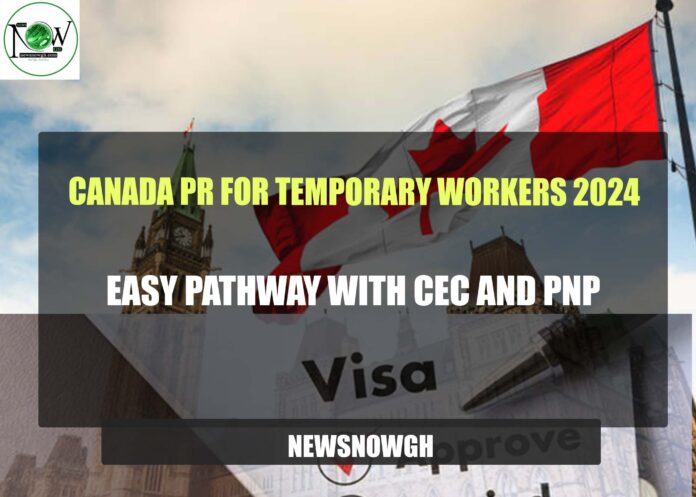Canada PR for Temporary Workers 2024: Easy Pathway with CEC and PNP
These days, a lot of temporary foreign workers in Canada are applying for permanent residency through two main schemes. The Provincial Nominee Programs (PNP) and the Canadian Experience Class (CEC) are these programs. This tendency is illustrated by a recent Statistics Canada report. It indicates that more workers are benefiting from these economic immigration initiatives by obtaining permanent residence.
Main Pathways for Permanent Residency
Canadian Experience Class (CEC) and Provincial Nominee Programs (PNP)
The most popular options for temporary employees wishing to remain in Canada permanently are now the CEC and PNP. These initiatives are currently more well-liked than others, such as the caregiver and Federal Skilled Worker Programs (FSW).
Statistics on Permanent Residency
Over 955,000 temporary foreign employees who obtained their first work licenses between 2006 and 2020 had become permanent residents by the end of 2022. This is a significant shift that indicates the use of economic immigration schemes by workers has increased.
Through economic programs, 86% of people who obtained their first work permits between 2006 and 2010 became permanent residents. For individuals who obtained their first work permits between 2016 and 2020, this percentage increased to 93%.
Data on Transition to Permanent Residency
| Work Permit Period | Percentage Transitioning to PR through Economic Programs |
| 2006 – 2010 | 86% |
| 2016 – 2020 | 93% |
COVID-19 Pandemic Impact
Experts advise us to exercise caution when examining these figures. The COVID-19 pandemic altered the procedure for obtaining permanent resident permits. Due to particular procedures implemented during the epidemic, a large number of applications were processed through the CEC. This has an impact on the general trend.
Expansion of the Graduate Work Program (PGWP) and Engagement of Families
The Post-Graduate Work Program’s (PGWP) expansion is a major factor in the rise in the use of economic immigration schemes. Additionally, a growing number of foreign students and skilled workers’ wives and common-law partners are obtaining permanent residency. The number of these family members moving here permanently has increased significantly.
Data on PGWP and Spouses/Common-Law Partners
| Work Permit Period | Share of PGWP and Spouses/Common-Law Partners Transitioning to PR |
| 2006 – 2010 | 29% |
| 2016 – 2020 | 73% |
The Significance of Economic Programs
The information demonstrates how crucial economic programs are to obtaining permanent residence. Well-structured programs such as the PNP and CEC provide temporary workers with a clear route to permanent residency.
How CEC and PNP Work
For those who have prior job experience in Canada, there is the Canadian Experience Class (CEC). You need to have at least a year’s worth of competent job experience in Canada to apply through CEC. It will be simpler for you to relocate permanently if you have this experience, which helps you grasp the Canadian work climate.
Provinces and territories can designate individuals who wish to reside and work in a particular province through the Provincial Nominee Programs (PNP). Every province has a unique PNP with distinct specifications. Your prospects of obtaining permanent residency are increased if you are nominated by a province.
Benefits of CEC and PNP
Canadian Experience Class (CEC)
- Work Experience: Employers value the Canadian work experience that CEC applicants already possess.
- Language Proficiency: Most applicants speak French or English fluently, which is helpful in both job and daily life.
- Quick Processing: Compared to other programs, CEC applications are frequently processed more quickly.
Provincial Nominee Programs (PNP)
- Provincial Needs: PNP focuses on particular talents that the province needs, which facilitates job searching.
- Increased Chances: Having a province nominate you increases the likelihood that you will be granted permanent residence.
- Community Integration: PNP offers information and assistance to assist you in settling into a particular community.
Obstacles and Things to Think About
These programs are helpful, but there are certain drawbacks. Application procedures can be intricate and call for thorough planning. It’s crucial to fulfill all requirements and offer correct data. Furthermore, modifications to immigration laws may have an impact on your application, so it’s important to keep up to date.
Conclusion
The Canadian Experience Class (CEC) and Provincial Nominee Programs (PNP) are being used by more temporary foreign workers in Canada to obtain permanent residency status. Workers who want to settle in Canada have access to efficient and transparent paths through these programs. This trend has also been aided by the expansion of the Post-Graduate Work Program (PGWP) and the involvement of common-law partners and spouses.
Temporary workers can obtain permanent residency by selecting these economic immigration schemes and using their Canadian work experience and provincial nominations. It’s critical that applicants thoroughly consider their submissions and remain up to date on the requirements.
Important Considerations:
Keep Up with the Requirements: Immigration laws are subject to change. For up-to-date details on eligibility for the PNP and CEC programs, visit the official Immigration, Refugees, and Citizenship Canada (IRCC) website regularly at https://www.canada.ca/en/immigration-refugees-citizenship.html.
Follow us on Newsnowgh.com to stay updated on the latest information regarding work permits, visa application processes, paths to permanent residency, and visa-sponsored employment.


